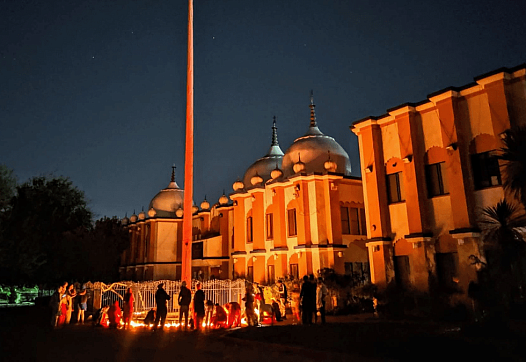Language barriers cripple Sikh immigrants’ access to health care
The story was originally published by IndiaCurrents with support from our 2025 California Health Equity Fellowship.
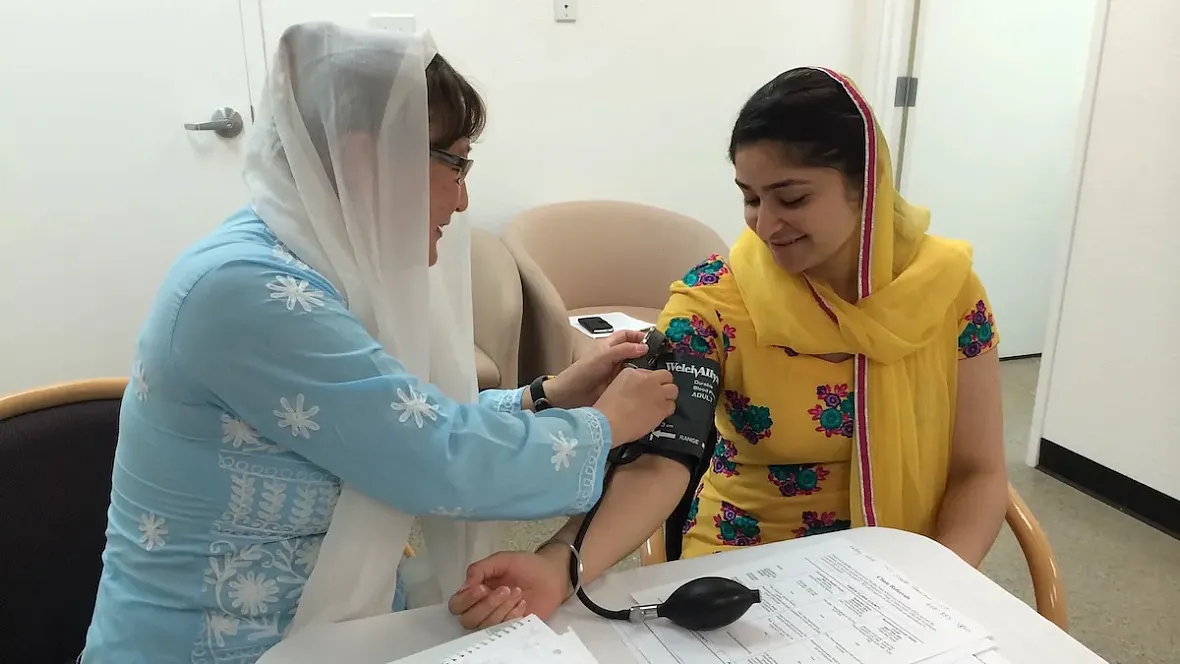
Image credit: Gurpreet Kaur Padam.
At his day job, Harpreet Singh Pannu is a physician specializing in internal medicine at Kaiser Permanente facilities in San Jose and Santa Clara. But on Sundays, at his sangat (congregation), Pannu encounters an altogether different set of challenges at the free medical clinic he runs at the San Jose Gurdwara.
He recently saw an elderly Sikh woman who was complaining of chest pain. His diagnosis found that her cardiovascular symptoms were so serious that she needed to visit the ER. But the woman was apprehensive; her English was not fluent, and she was unsure of seeing a physician who did not speak Punjabi; would the doctor understand her and take care of her properly? Dr. Pannu explained the gravity of the situation to the woman and assured her that the doctors at the hospital would take good care of her. He then called for an ambulance to take the woman straight from the gurdwara to the ER.
A few days later, he saw another woman who revealed that she was facing severe depression, exacerbated by abuse at home. Like many South Asian communities, domestic abuse carries a major stigma, and she did not know where to seek help for herself. After she confessed to ideating self-harm, Dr. Pannu connected her with two local organizations helping South Asian female domestic violence survivors.
“I cover everything from medical issues to mental health issues, to social issues, too,” he said. “It’s kind of multi-faceted.”
First-generation Sikh immigrants are one of the largest Indian immigrant groups in the state; however, they remain invisible in medical settings: They are vulnerable to health challenges because of lower income and education levels, engagement in physically strenuous blue-collar jobs, uncertainty around immigration status, and, most importantly, language barriers in accessing care.
Dr. Pannu — who runs the clinic with his son and pre-med student Daleep Singh Pannu — is one of the few Punjabi-speaking healthcare practitioners who serve as the initial point-of-contact for many first-generation Sikh immigrants seeking culturally congruent care in California. As the ongoing immigration crackdown breeds further distrust of traditional healthcare facilities in the state, community clinics like Dr. Pannu’s are stepping in to fulfill health needs that remain underserved.
What the data says about Sikhs’ health needs
The Sikh Coalition, a national advocacy group, believes that between 500,000 and 750,000 Sikhs* are in the United States. Of these, half are estimated to be living in California. The first Sikh immigrants came to California as far back as the early 1900s, settling in the state’s fertile valleys that mirrored the rich farmlands of their homeland, Punjab, in present-day India and Pakistan.
More than a century later, economic and political uncertainty in the Indian state of Punjab continues to drive the migration of Sikhs — mostly young men — to California, often as undocumented immigrants** or asylum-seekers. The sharp rise in low-income Punjabi-speaking immigrants is reflected in the number of newly Medi-Cal-eligible individuals from 2021 to 2024.
They take up jobs as truck drivers, agricultural laborers, service industry employees, taxi drivers, and other blue-collar jobs, often working more than one shift a day to meet the financial pressures of sending money back home while making a livelihood in California. This lifestyle gives rise to physical injuries, mental health issues like depression and anxiety, and aggravates chronic illnesses like hypertension, cardiovascular disease, and diabetes that South Asians are already predisposed towards.
Punjabi speakers are also less likely to be fluent in English, as compared to other Indian-language speakers.
According to data published in 2021 by the California Department of Health Care Access and Information (HCAI), 18,660 patients chose Punjabi as their preferred language during recorded encounters at hospitals, the highest among South Asian languages. The next-highest South Asian language was Hindi at 5,670.
The combination of low-income, physical labor jobs and a high incidence of medical problems makes first-generation Sikh immigrants among the most vulnerable South Asian groups in the state. A relatively low fluency in English creates a potent language barrier that exacerbates the community’s health needs, as attested to by Punjabi-speaking health practitioners like Dr. Pannu.
*2020 census records show that there are around 120,000 individuals who identify at least partly as Sikh. However, the Sikh Coalition believes that this is a serious undercount, pointing to the fact that census respondents had to write in “Sikh” as an option under ethnicity, which is not intuitive. Source: Sikh Coalition
**Though reliable statistics are not available, it is believed that Sikhs form a large proportion of the Indian undocumented immigrant population in the United States, numbering between 350,000 to 725,000. Source: Migration Policy Institute, Pew Research Center
Overcoming the language barrier with free medical clinics
San Mateo-based family medicine specialist Dr. Gurpreet Padam witnessed the impact of this gap every time she visited the San Jose Gurdwara to worship; Sikh congregants would accost her to ask for help decoding MRIs and X-rays, setting up their insurance, and prepping for doctors’ appointments.
In 2010, armed with a stethoscope and a prescription pad, Padam and two friends from the sangat — a clinical operations manager and a family attorney — set up a table in the gurdwara’s langar hall (community dining space) with a handwritten sign saying ‘clinic’. In 2014, the gurdwara created a permanent space for them, establishing the Guru Nanak Free Medical Clinic. Drs. Padam and Pannu were among the four doctors who volunteered their time every Sunday to run the clinic.
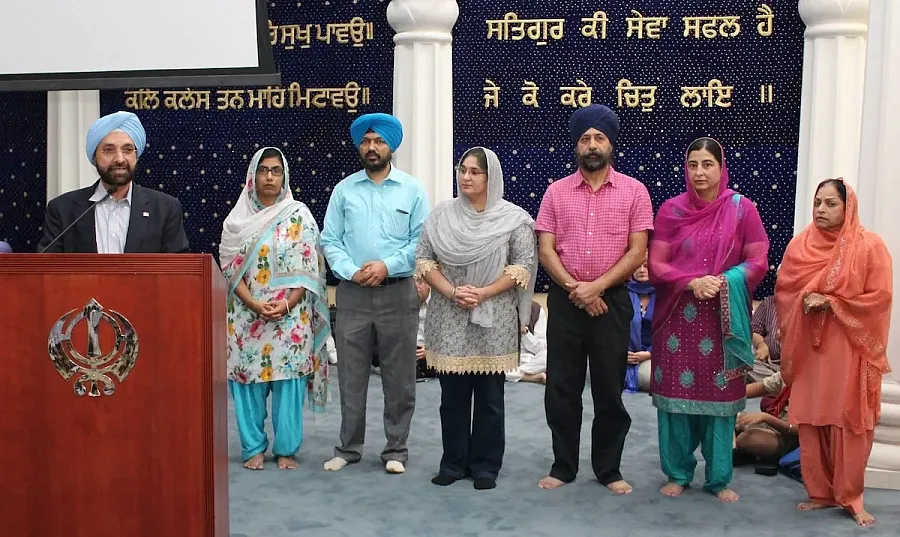
The medical staff of the Guru Nanak Free Medical Clinic addresses the sangat at the San Jose Gurdwara. Dr. Pannu (second from left) and Dr. Padam (third from left) have been working at the clinic since its inception in 2014.
Image credit: Gurpreet Kaur Padam.
The clinic now sees patients suffering from diabetes, hypertension, skin infections, common respiratory diseases, as well as serious issues like malignant cancers, heart disease, and accidental injuries. As the trust grew stronger between the doctors and the community, patients suffering from alcohol, substance dependency, and domestic violence — issues that carry a stigma in the community — also started visiting the clinic to seek care.
“As soon as someone identifies that you’re Sikh and you speak Punjabi, there’s that instant connection and there’s that level of trust that you gain,” she said. “That’s a really big issue for people to be able to trust that you’re not going to shame them with these sensitive issues.”
Since 2016, Dr. Padam has served in an advisory capacity, while Dr. Pannu acts as the clinic’s Director, seeing between 10 to 35 patients every Sunday afternoon. Most of these patients are uninsured, either because they don’t qualify for Medi-Cal or don’t know how to access it.
Much of Dr. Pannu and Dr. Padam’s work at the clinic involves educating patients about navigating the healthcare system and answering queries that might seem rudimentary to a native English speaker who has lived in the US all their life.
For instance, they advise patients on questions they should ask their primary care provider, write down accurate descriptions of their symptoms in English, educate them about all the options they have after diagnosis, and review eligibility for insurance options like Medi-Cal. Occasionally, the clinic sees patients who work as physical laborers present with occupational injuries; they are unaware that their employers are legally required to pay for their treatment.

The San Jose Gurdwara, where the Guru Nanak Free Medical Clinic is located.
Photo by Tanay Gokhale.
Healthcare facilities often contract with interpretation services to offer in-language support to patients, but Punjabi language services are unreliable.
“It’s very much an informal process,” said Daleep Singh Pannu, Dr. Pannu’s son, who, apart from volunteering at his father’s clinic, also volunteers at the Santa Clara Valley Medical Center. “There’s dozens of times when they’ve had somebody wait on the side for me to come back and do translator services for them, because the interpreter service doesn’t have a Punjabi speaker available at the time.”
“Patients need to realize that they’re an active participant in their care, that they’re in control, and they are allowed to ask questions,” said Dr. Padam. “I think language is a big barrier, because when you don’t feel comfortable speaking with your provider, a lot gets lost in translation.”
Seniors at risk
In her freshman year, Harjot Kaur Gakhal, a recent UC Berkeley graduate, volunteered with a community health clinic at the Pittsburgh Gurdwara and saw firsthand the health challenges faced by elderly Sikhs.
“A lot of these people started talking to me about so many of the problems that they’re having, even though I wasn’t qualified — and I made sure they knew that — but they just wanted someone that would listen to their concerns, someone that could actually understand what they’re going through,” she said. “They can’t really talk about this stuff with their friends or family without making it a problem, so they were talking to a random stranger, just because they feel like they’re going to listen.”
Many older Sikh immigrants immigrated from Punjab around 1984 to escape persecution during a period of anti-Sikh violence in India. Gakhal’s father was one of them, fleeing Punjab for the U.K., before seeking asylum in the U.S. and settling down with his family in California. Gakhal is the first person in her family to be born in the United States and to attend college. Her Sikh upbringing and the experiences of first-generation immigrants like her parents have informed the career path she has chosen for herself.
“I feel like there’s so much unprocessed pain from the Partition [of India and Pakistan], 1984 [anti-Sikh riots], coming here, and there’s so much that I feel like people don’t often consider,” said Gakhal, who majored in Psychology.
Gakhal explains that elderly Sikhs often lack the vocabulary to deal with mental health issues because of the social stigma associated with this subject. Even if they want to seek help, they are hampered by language barriers, cultural stigma about seeking help, and a dependency on their children for transportation and interpretation.
The Khalsa Community Center, a Fresno-based organization, was set up in 2024 to address the needs of Sikh seniors and the community. The nonprofit offers free mental health services in Punjabi, provides free Punjabi tutoring to Sikh children, and conducts monthly events specifically for Sikh seniors.
Director Prableen Kaur said that senior events are among their most popular offerings, a reflection of how beneficial these interventions are to older Sikhs.
“They might have come from India… they’re at home and everyone’s at work, and they’re disconnected because they might not have access to technology,” she said. “They’re totally in isolation.”
The senior events draw up to thirty participants every month, making them one of the center’s most successful interventions. Kaur explained that on most occasions, she and her team drive around Fresno offering rides to seniors who do not have transportation to access the facility. At the Center, the seniors play board games, Jenga, and Punjabi Bingo, followed by short spiritual discourses discussing Sikhi (practicing Sikhism).
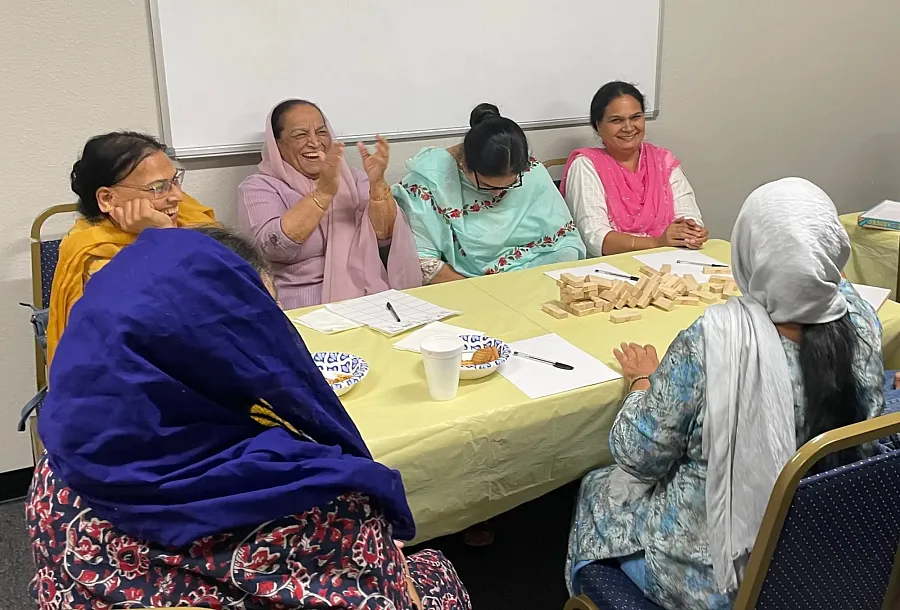
Senior game nights at the Khalsa Community Center include Jenga, Punjabi Bingo, and other board games, followed by a short spiritual discourse about the tenets of Sikhi. Photo by Tanay Gokhale.
Photo by Tanay Gokhale.
One of the regular participants for the seniors game night, Kamaljeet Pandher, has been in the healthcare industry herself since 2008 as a registered nurse. She explained that Punjabi seniors are often eligible for healthcare services that they are unaware of, like the annual $3100 grant for diabetes patients offered by the Patient Access Network Foundation; preventative care like the shingles vaccination, and In-Home Service Support through Medi-Cal. Often, seniors lack the means to access them.
“It’s not like we don’t have resources, but the problem is that we don’t know how to access them, and we need social workers like this [Khalsa Community Center] to help us,” she said. “It’s a problem of lack of knowledge and education.”
Undocumented immigrants vulnerable
Undocumented immigrants and asylum seekers are living in the existential fear of being detained or deported following the ICE crackdowns. Over the last few months, at a time when they are afraid to seek out health resources for fear of attracting ICE’s attention, the South Asian Network (SAN), a Southern California-based nonprofit that advocates for South Asians has stepped in with their Community Health Action Initiative (CHAI), reaching out to immigrants and connecting them with healthcare resources.
Balvinder Kaur of SAN has volunteered at more than a dozen gurdwaras across southern California to educate Sikh immigrants about MediCal, and help set up health resources and provide in-language support for health needs. Despite the steady rise in the MediCal eligible population, she believes that there needs to be more outreach, as many Sikh immigrants are unaware of the program and are missing out on affordable coverage.
Previously, SAN informed immigrants that enrolling for Medi-Cal would not impact their immigration status, but they are unsure after recent reports that President Trump authorized ICE to access Medicaid data. “We are also scared to recommend [enrolling for MediCal] to our clients, because we don’t know what the next steps are from this administration,” said Balvinder Kaur.
In the past few weeks, she has personally bought and delivered groceries to Sikh immigrant families, who avoid grocery stores for fear of ICE raids. These families are equally afraid of going to healthcare facilities, and looming dangers are taking a toll on their mental health.
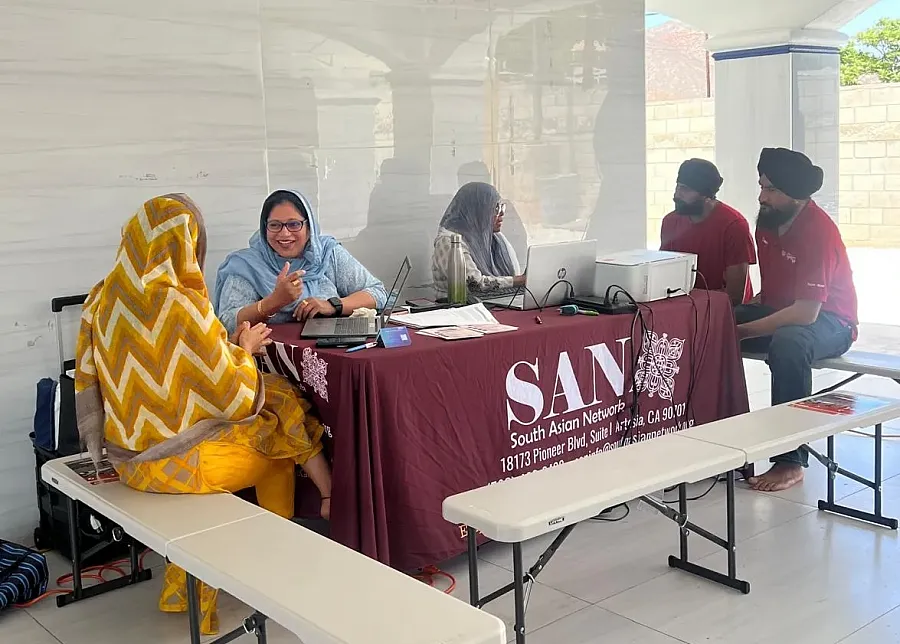
Balvinder Kaur (second from left) during an SAN outreach session for the Sikh community at the Riverside Gurdwara.
Image credit: South Asian Network.
The Khalsa Community Center offers free therapy in Punjabi and does not ask for insurance information. In the year since its establishment, the organization’s on-staff therapist has treated around a hundred clients, many of whom attend regular therapy sessions.
“We’ve never not had a waitlist, so we reached capacity pretty quickly,” said Kaur. “There’s clearly a huge, massive gap that we’re barely filling.”
Unfortunately, undocumented workers, who are the most in need of mental health services at the moment, are unable to commit to regular therapy sessions, explained Kaur, as they have to work longer hours or find additional jobs to secure their finances. Some have turned to substance and alcohol abuse to cope with their circumstances.
The Center has recently started a Punjabi alcohol and drug abuse support group, aiming to tackle addiction issues through open conversations in Punjabi rooted in Sikh spirituality.
“There needs to be a systematic way to help them and support them, and we’re doing that through the support group and including culture and spirituality in that, because our community needs that,” said Kaur. “They didn’t even know that they could get help for these feelings that they’re feeling.”
The way forward
The need for in-language support for Punjabi speakers is a common point of concern among Sikh doctors and healthcare social workers in California, and there have been legislative attempts in the past to fulfill this need.
Assemblymembers Rudy Salas and Ash Kalra introduced Bill 3179 in 2018, seeking to lower the criteria for threshold languages and require state agencies to offer translations and interpretation for Punjabi speakers. The bill passed through the Assembly and the Senate, but Gov. Edmund Brown vetoed it, citing the additional cost that it would entail. Currently, Punjabi meets the threshold language criteria in only one county in California, even though Punjabi is the third most spoken language after English and Spanish in many counties.
Last year, Sikh Assemblymember Jasmeet Kaur Bains successfully passed the ‘Grow Your Own Bill,’ which called for the development of a University of California medical school in Kern County that will train doctors from the local communities, including the Sikh immigrant communities.
Through Sikh student clubs across university campuses, first- and second-generation Sikh youth are also taking up the mantle of fulfilling their community’s health needs. The Bhagat Puran Singh Health Initiative (BPSHI) is a California-wide organization through which Sikh university students conduct regular health screenings and pop-up clinics at gurdwaras. Both Harjot Kaur Gakhal and Daleep Singh Pannu have volunteered with BPSHI and are now charting their path in healthcare services.
Gakhal is currently working on getting her therapist’s license and wants to open a clinic where marginalized communities can overcome cultural stigma and language barriers to get help. “I plan to pursue a PhD to study intergenerational trauma within the Sikh community,” she said. “I also want to explore what kind of healing approaches and interventions would actually work for us.”
Inspired by his own experience caring for his grandfather towards the end of his life, Daleep Singh Pannu juggles his medical studies at UC Berkeley, volunteering at his father’s clinic on Sundays, and volunteering at local medical facilities where he helps with interpretation for Punjabi and Spanish speakers.
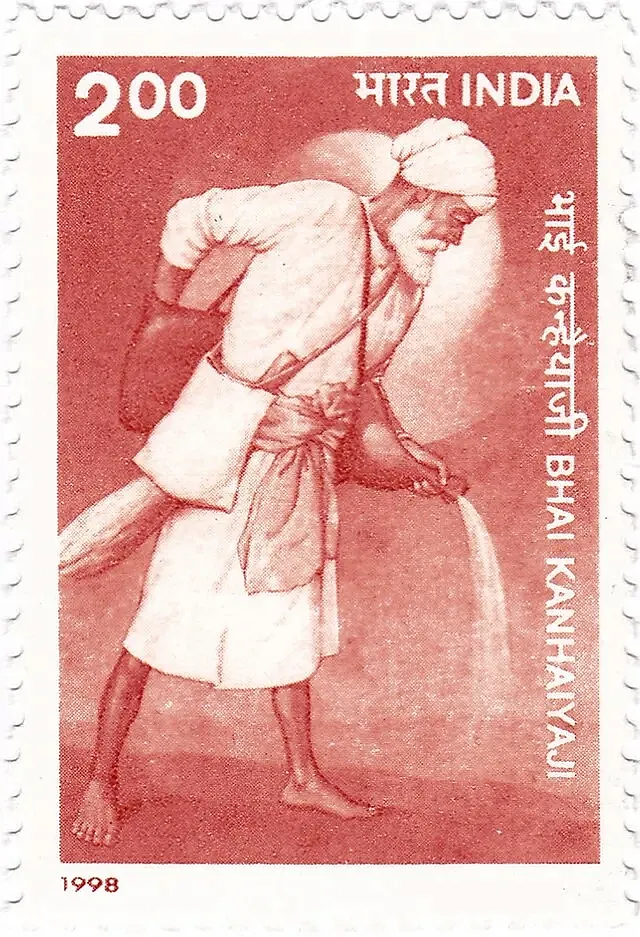
A postal stamp depicting the 18th-century Sikh water-carrier Bhai Kanhaiya.
Image credit: India Post, Government of India via Wikimedia Commons, licensed under GODL.
“As soon as you start speaking to them in their mother tongue, their body language completely changes,” he said. “So even in these small jobs where you’re not necessarily providing a lot in terms of actual medical care, you’re still improving their experience within the medical field overall.”
He sees service as an essential part of Sikhism, and a guiding principle for his own life. He cites the example of Bhai Kanhaiya, an 18th-century Sikh water-carrier:
“He’s a medic on the battlefield when the Sikhs are fighting against the Mughals, and he’s delivering water and medical aid to everyone. The big question like, why are you healing and helping out the enemy?” said Pannu. “The way I see it is, if he has the water, why not? If you have the resources and the capacity to help, why not?”


